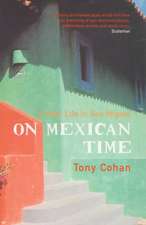Mapping Central Asia: Indian Perceptions and Strategies
Autor Sébastien Peyrouse Editat de Marlène Laruelleen Limba Engleză Paperback – 17 oct 2016
| Toate formatele și edițiile | Preț | Express |
|---|---|---|
| Paperback (1) | 322.89 lei 6-8 săpt. | |
| Taylor & Francis – 17 oct 2016 | 322.89 lei 6-8 săpt. | |
| Hardback (1) | 823.26 lei 6-8 săpt. | |
| Taylor & Francis – 16 aug 2011 | 823.26 lei 6-8 săpt. |
Preț: 322.89 lei
Preț vechi: 431.28 lei
-25% Nou
Puncte Express: 484
Preț estimativ în valută:
61.78€ • 67.32$ • 52.06£
61.78€ • 67.32$ • 52.06£
Carte tipărită la comandă
Livrare economică 23 aprilie-07 mai
Preluare comenzi: 021 569.72.76
Specificații
ISBN-13: 9781138256811
ISBN-10: 1138256811
Pagini: 262
Dimensiuni: 156 x 234 mm
Greutate: 0.39 kg
Ediția:1
Editura: Taylor & Francis
Colecția Routledge
Locul publicării:Oxford, United Kingdom
ISBN-10: 1138256811
Pagini: 262
Dimensiuni: 156 x 234 mm
Greutate: 0.39 kg
Ediția:1
Editura: Taylor & Francis
Colecția Routledge
Locul publicării:Oxford, United Kingdom
Notă biografică
Marlène Laruelle is a Research Professor at the Institute for European, Russian and Eurasian Studies (IERES), The Elliott School of International Affairs, George Washington University, Washington DC, USA. Her main areas of expertise are nationalism, national identities, political philosophy, intellectual trends and geopolitical conceptions of elites in Russia and Central Asia.
Recenzii
'Laruelle and Peyrouse offer a seminal addition to the literature and partially fill the void in scholarship on Central Asia from the South Asian perspective. Given India's rise as a regional power and strategic player, this book should be on the shelf of every student and specialist of Central Asia, and is required reading for those formulating policy on the region.' Reuel R. Hanks, Oklahoma State University, USA 'India is the looming, yet poorly understood big actor in the strategic competition for the heart of Eurasia. This book offers a wealth of unique insights into how Indians themselves understand the shape and dynamics of this accelerating contest.' S. Enders Wimbush, German Marshall Fund of the United States 'Confirming the shift of power eastwards, India has been depicted as a rising global power. Yet, the complex political, economic, cultural and strategic contexts of such a rise have surprisingly been overlooked by commentators. Not anymore! This timely volume provides a rare and comprehensive overview of India's international interactions with Central Asia. The wealth of solid knowledge and sharp insights demystifies the 'new great games' in the region and constructs a prescient account of the strengths and weaknesses both of India's external relations and its Central Asian policy.' Emilian Kavalski, University of Western Sydney, Australia 'This rare collection of essays by primarily Indian scholars provides a masterful analysis of Central Asia's role in India's Look-North policy. The authors' underlying premise that the current striking gap between possibility and reality in India's relations with Central Asia is inconsistent with India's rise and Central Asia's intended geopolitical diversification, suggests a looming major change in the regional security dynamics worth paying attention to.' Rouben Azizian, Asia-Pacific Center for Security Studies, Honolulu, USA '... the essays are rich in argument and empirics, and the volume is a boon for an
Cuprins
Introduction, MarlèneLaruelle, SébastienPeyrouse; Part I The Past as a Link? Reassessing Indo-Central Asian History; Chapter 1 Foreign Policy and Myth-making, MarlèneLaruelle; Chapter 2 Bukhara in a Revolutionary Time and its Indian Connections, SuchandanaChatterjee; Chapter 3 The Opening and Closing of Direct Indo-Central Asian Relations, 1924–1940, SurendraGopal; Chapter 4 Perceptions and Strategies, AnitaSengupta; Chapter 5 The Revival of the Silk Roads Topic, SreematiGanguli; Part II Contextualizing Indo-Central Asian Relations; Chapter 6 Domestic and International Articulations of the Indian Involvement in Central Asia, SébastienPeyrouse; Chapter 7 Framing Indo-Central Asian Relations, 1990s–2000s, AjayPatnaik; Chapter 8 India’s New Look at Central Asia Policy, Jagannath P.Panda; Chapter 9 Indo-Central Asian Economic Relations, GulshanSachdeva; Part III The In-Between Points of Tension; Chapter 10 Managing Regional Geopolitical Uncertainty, MarlèneLaruelle, SébastienPeyrouse; Chapter 11 India’s Policy towards Central Asia, MeenaSingh Roy; Chapter 12 Restoring India’s Links with Central Asia across Kashmir, Mushtaq A.Kaw; Chapter 13 The Resurgence of the Taliban and Regional Security Concerns, AjayDarshan Behera; Chapter 14 The Xinjiang Issue, K.Warikoo; Chapter 101 Conclusion, MarlèneLaruelle, SébastienPeyrouse;
Descriere
With renewed American involvement in Afghanistan, Pakistan's growing fragility, and China's rise in power in the post-Soviet space, Central Asia-South Asia relations have become central to understanding the future of the Eurasian continent. Mapping Central Asia identifies the trends, attitudes, and ideas that are key to structuring the Central Asia-South Asia axis in the coming decade.




